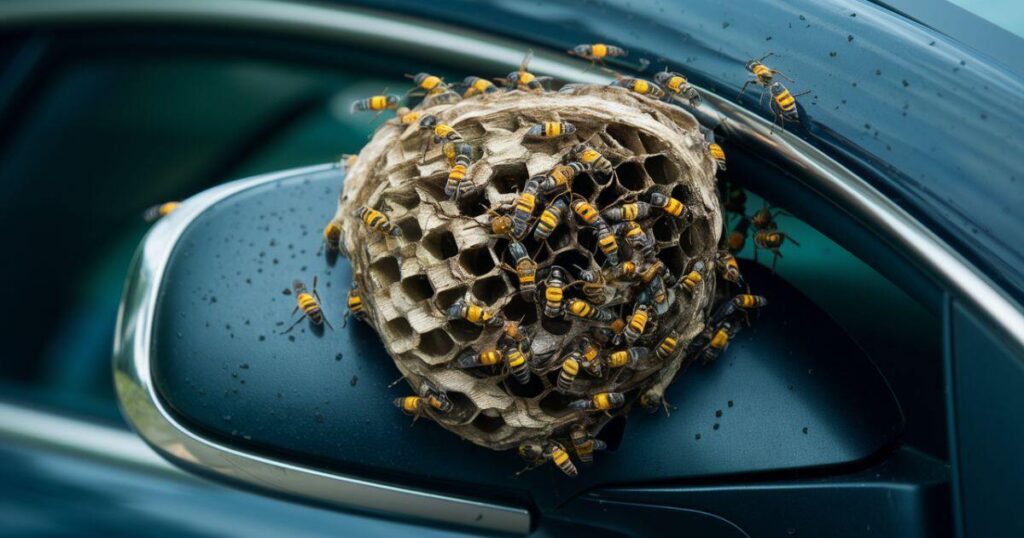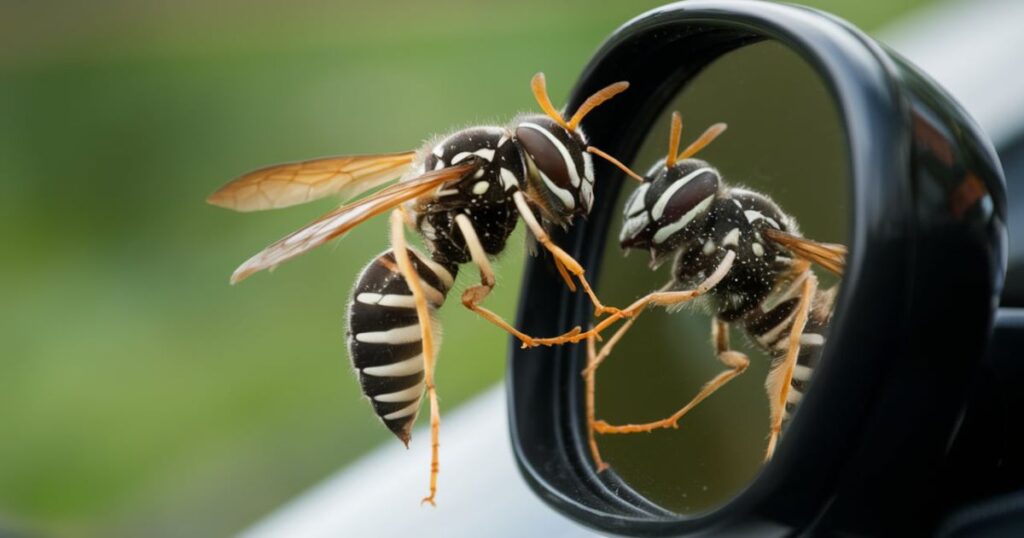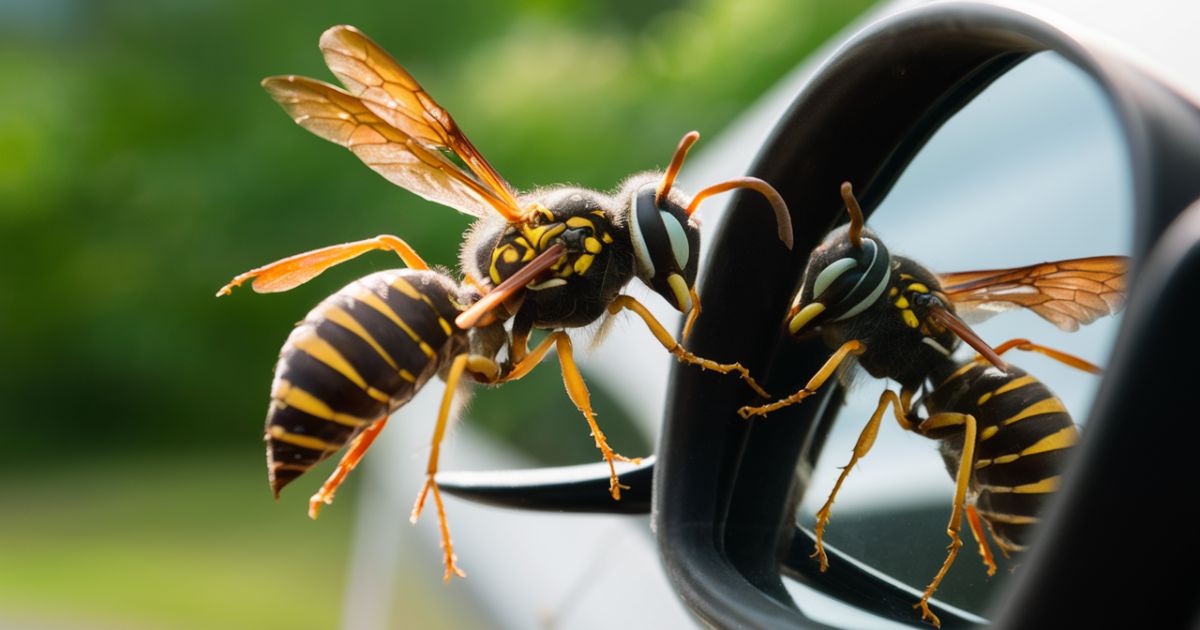Have you ever walked up to your car, only to find a buzzing wasp circling your side mirror? You’re not alone. Across the USA, drivers have been puzzled by this strange phenomenon.
Why do wasps like car mirrors? It’s a question that’s sparked curiosity and, sometimes, a bit of fear. Let’s dive into the fascinating world of these striped insects and uncover the mystery behind their mirror mania.
Key Takeaways
Before we delve deeper, here are the main points you’ll want to remember:
- Wasps’ attraction to car mirrors isn’t random – there’s a method to their madness
- Reflections, shelter, and warmth all play key roles in this behavior
- Understanding wasp behavior can help prevent nest-building on your vehicle
- Safe removal techniques exist for dealing with existing nests
- Certain times of the year see increased wasp activity around car mirrors
The Curious Behavior of Wasps
Wasps are more than just picnic-runners and garden pests. These insects are complex creatures with fascinating behaviors. They’re known for their intelligence, ability to recognize faces, and their crucial role in ecosystems as pollinators and pest controllers.
But their tendency to explore man-made structures, including our beloved vehicles, often puts them at odds with humans. This exploration isn’t random. Wasps are always on the lookout for suitable nesting sites, and sometimes, our car mirrors fit the bill perfectly.
Reasons for Wasps’ Fascination
So, why do wasps like car mirrors? There are several factors at play:
- Reflective surfaces: Wasps may be attracted to their reflection, mistaking it for another wasp. This can trigger territorial behavior.
- Shelter and protection: The space behind a car mirror provides an ideal sheltered spot for nest-building, protected from rain and wind.
- Warmth: Car mirrors, especially dark-colored ones, can retain heat, making them attractive to wasps seeking warmth.
- Territorial behavior: Some wasps may perceive their reflection as a rival, leading to aggressive behavior around the mirror.
Wasp Nest in Car Mirrors
When a wasp decides your car mirror is prime real estate, it doesn’t waste time. Wasp nest construction is a marvel of insect engineering. They start by chewing wood or plant fibers, mixing it with their saliva to create a paper-like material. This is then molded into the familiar hexagonal cells we associate with wasp nests.
Car mirrors make attractive nesting spots because they offer:
- Protection from the elements
- A secure attachment point
- Easy access for the wasps
However, a wasp nest in your car mirror isn’t just an inconvenience. It can pose risks to your vehicle, potentially damaging the mirror mechanism or leaving residue that’s difficult to clean.

Common Types of Wasps
Not all wasps are created equal. In the USA, you’re likely to encounter several species, each with its characteristics:
| Wasp Type | Appearance | Nesting Habits | Aggression Level |
|---|---|---|---|
| Paper Wasps | Slender, with long legs | Open nests, often under eaves | Moderate |
| Yellow Jackets | Black and yellow striped | Ground or cavity nests | High |
| Hornets | Larger, black and white | Large, enclosed nests in trees or buildings | High |
| Mud Daubers | Thin-waisted, often black | Mud nests in sheltered areas | Low |
Each of these wasps might find your car mirror appealing for different reasons, but they all share a fondness for protected warm spaces.
Finding Wasp Nests in Common Areas
While car mirrors are an unusual spot, wasps build nests in various locations. Understanding these can help you better comprehend their attraction to your vehicle:
- Under eaves and overhangs
- In wall cavities
- Inside hollow trees
- Underground in abandoned rodent burrows
- In sheds or garages
Compared to these spots, car mirrors offer similar benefits: shelter, warmth, and protection. The key difference? Your car moves, which can be disorienting for the wasps.
Safely Removing a Wasp Nest
If you find a wasp nest on your car mirror, don’t panic. There are safe ways to remove it:
- DIY methods:
- Wait until evening when wasps are less active
- Spray the nest with a commercial wasp killer
- After ensuring the wasps are dead, remove the nest wearing protective gear
- When to call professionals:
- If you’re allergic to wasp stings
- If the nest is large or in a hard-to-reach place
- If you’re dealing with aggressive species like hornets
- Safety precautions:
- Always wear protective clothing
- Have an escape route planned
- Never attempt removal if you’re allergic
Remember, your safety comes first. When in doubt, it’s always better to call a professional.
Preventive Measures Against Wasp Nests
An ounce of prevention is worth a pound of cure. Here are some strategies to keep wasps away from your car mirrors:
- Regular car washing: Keeps your mirrors clean and less attractive to wasps
- Use of repellents: Natural options like peppermint oil or commercial sprays can deter wasps
- Parking strategies: If possible, park in enclosed areas or cover your mirrors when the car is stationary for long periods
The Science Behind Wasps’ Attraction to Car Mirrors
Diving deeper into the “why do wasps like car mirrors” question, we find some fascinating science. Wasps, like many insects, are attracted to UV light. Car mirrors, especially those with a slight blue tint, can reflect UV light in a particularly appealing way to wasps.
Moreover, the shape and positioning of car mirrors mimic natural structures that wasps might use for nesting in the wild, such as rock overhangs or tree hollows. This familiarity makes them an instinctively attractive option.

Conclusion
The attraction of wasps to car mirrors is a perfect example of how human infrastructure can unexpectedly intersect with nature. While it can be annoying or even scary to find wasps buzzing around your vehicle, understanding their behavior can help us coexist more peacefully with these important insects.
Remember, wasps play crucial roles in our ecosystems. They’re not out to get us – they’re just looking for a home, and sometimes our cars seem like the perfect spot. With the knowledge you’ve gained from this article, you’re now equipped to handle this situation safely and effectively.
Frequently Asked Questions
How Do Wasps Benefit From Building Nests in Car Mirrors?
Wasps build nests in car mirrors for shelter and protection from predators and the elements. The enclosed space provides an ideal environment for the queen to lay eggs and raise larvae.
Can Wasps Cause Damage to Car Mirrors?
While wasps themselves don’t typically damage car mirrors, their nests can leave residue and marks that may be difficult to clean. If not removed promptly, the nests could also interfere with the mirror’s functionality.
Are Certain Car Mirror Designs More Attractive to Wasps?
Yes, certain car mirror designs with larger, more enclosed spaces are more attractive to wasps for nesting. Mirrors with gaps or crevices provide the ideal conditions for wasps to build and protect their nests
Do Wasps Prefer Certain Car Colors Over Others?
There’s no definitive evidence that wasps prefer specific car colors. However, darker colors tend to retain more heat, which could make them slightly more attractive to wasps seeking warm nesting sites.



